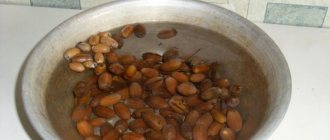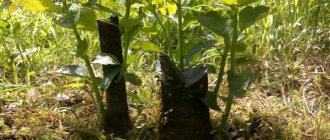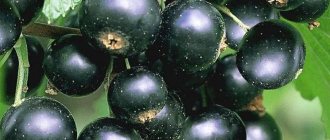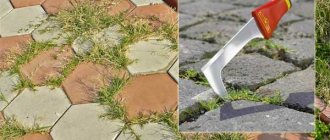Evergreen coniferous shrubs are among popular ornamental crops, widespread throughout Russia. Among them, various varieties of juniper are very popular, whose diversity allows you to choose the appropriate landscaping option even for small areas, as well as for gardens with complex terrain. Thanks to their unpretentiousness and resistance to drought and frost, juniper bushes successfully take root in regions with harsh climates. The low-growing Chinese juniper Mint Julep stands out among its fellows with an unusual aroma, which, in addition to the usual smell of pine needles, has fresh minty notes. This spreading variety is a hybrid and is the result of crossing a Chinese and a Cossack variety of juniper. This article will discuss the characteristic features of the horizontal juniper variety Mint Julep, as well as how to properly care for it.
Medium juniper Mint Julep: variety description
The average juniper, Mint Julep, is a hybrid variety of American origin, developed in the mid-20th century thanks to the efforts of plant breeders from New York State. This variety of juniper owes its name to the famous alcoholic cocktail “Mint Julep” in the southern United States, to which, in addition to pieces of ice, bourbon and sweet syrup, mint leaves are added.
The exquisite aroma of the shoots of a hybrid juniper variety really evokes associations with a mint cocktail. Juniper bushes "Mint Julep" are lush and soft, their shoots bend in an arc towards the ground, forming an angle of about 45 degrees. The scales of thick needles are painted in different shades of green - from light, emerald, to rich and dark. Small round fruits resemble blue cones covered with a bluish coating.
One of the distinctive features of the Mint Julep variety, inherited from one of its parents, the Cossack juniper, is the high content of poisonous essential oils in the tissues of all parts of the bush. These toxic, strong-smelling substances are extremely dangerous to people and animals.
Like other junipers, Mint Julep is a dioecious shrub. You can distinguish male plants from female ones by the density of the crown (in the former it is usually thicker), as well as by the color of the cones in the flowering phase: on male specimens they have a yellow tint, on female ones they are light green.
Juniper variety "Mint Julep" has a number of advantages. These include the following qualities:
- resistance to severe frosts (up to -40 degrees) and drought;
- ability to withstand sudden and significant temperature changes;
- the variety takes root in an urban environment with its polluted and dusty air;
- has high growth rates relative to other varieties of juniper;
- can grow on soils of different composition;
- The average age of juniper bushes of this variety is about a century, which allows us to classify them as long-livers.
Description and advantages
This variety of juniper is characterized by the presence of a fairly spreading crown, the branches of which are located at an angle of 45° in relation to the ground. The variety was obtained by breeders from the American nursery in Saratoga Springs. The advantage of Juniperus media Mint Julep is its resistance to adverse weather and climatic conditions, including severe winter frosts and dry summer periods. The shrub can be grown either singly or in group plantings, creating a very decorative coniferous ensemble.
An adult plant is medium-sized, with an attractive wavy crown, which at the age of ten years can be three or more meters wide. A distinctive feature of the variety is the presence of a pronounced and very pleasant mint smell. In most cities of the originating country, this type of shrub is classified as industrial, which is due to its resistance to negative factors of the urban environment. Juniperus media Mint Julep is perfect for arranging hedges, as well as designing single or group compositions. The shrub is in great demand in the design of rocky and heather gardens, the design of alpine slides and modern roof landscaping.
Dimensions of an adult juniper plant Mint Julep
Since the Mint Julep variety was derived from two completely different species of juniper, the creeping Cossack and the tall Chinese, it ended up with average crown height and width. At the age of 10 years, juniper bushes of this variety reach their maximum height and degree of spreading. In favorable conditions and as a result of systematic care, some specimens can reach a height of 2 m, and the diameter of their crown is sometimes 3.5 m. The relative compactness of the Mint Julep juniper bushes, combined with the amazing flexibility of the fluffy shoots, allows them to be used for shaped landscaping in garden areas .
Selection of location and conditions of detention
Mint julep is a light-loving plant; you need to find a sunny place in the garden for it; light shade is also quite acceptable (see photo). He prefers soils that are well-drained, but not too acidic, otherwise the appearance of the shrub will suffer. Humidity and temperature do not matter for this plant.
Juniper Mint Julep in landscape design
Juniper Mint Julep in landscape design: photo
Despite the rather rapid growth of shoots, the Chinese juniper Mint Julep still grows quite slowly, so it does not cause much trouble for garden owners. After a shaping cut of the Mint Julep juniper, its crown retains its contours for quite a long time. These evergreen coniferous shrubs delight the eye with the greenery of their branches all year round, regardless of the season. Quite often, the Mint Julep variety is used to form standard bushes, as well as to construct figured compositions on frames. Flexible and long shoots of "Mint Julep" allow you to turn it into a creeping plant, securing the branches to the surface of the ground. This method is especially often used in areas with difficult terrain, when it is necessary to secure juniper bushes on a slope or slope.
In order to grow the Chinese juniper “Mint Julep” tall and strong, it is practiced to tie its shoots to a supporting structure. After some time, the flexible branches will get stronger and will constantly remain in an upright state. This versatility makes the Mint Julep variety a favorite of designers and gardeners, as it can be used to decorate gardens in a wide variety of styles. With equal success, Mint Julep juniper bushes can play the role of a bonsai tree, heather cover, vertical accent or element of the composition of a flower bed or alpine slide. Their soft fluffy shoots can serve as a background for other plants, or can act as a compositional dominant.
Its unpretentious nature and ability to survive in unfavorable conditions allows the Mint Julep juniper to be used for landscaping urban areas, creating green hedges along highways, and purifying the air near health and educational institutions.
Juniper variety "Mint Julep" gets along well next to other plant crops, be it other coniferous shrubs or trees, or deciduous or herbaceous plants. The combination of juniper with heather, rhododendrons, hydrangeas, and erica, whose flowers stand out effectively against the green background, looks especially advantageous. The only exception is fruit and berry crops, the proximity of which is undesirable.
Preparing for winter
The Juniperus media Mint Julep variety is characterized by fairly good resistance to frost and early autumn cold snap. However, it is best to cover young or recently planted junipers for the winter. For this purpose, you can use spruce branches or dry foliage. Over time, juniper shoots become woody and no longer respond even to fairly severe frosts. Therefore, adult plants do not need shelter, but to prevent the branches from breaking off under the weight of the snow mass, they need to be secured with a strong rope.
Medium Chinese juniper Mint Julep: planting and care
The Mint Julep variety will successfully take root in almost any soil. However, the best option for growing it is loose sandy and loamy soils. Despite its frost resistance, juniper is a light-loving crop, so it is recommended to choose a well-lit area for its placement. It will also survive in shade or partial shade without any problems, but its crown will lose its decorative qualities - it will become looser and duller. Drought does not threaten the health of these persistent coniferous shrubs, but excess moisture in the soil can lead to dire consequences - the root system will begin to rot, which can cause the death of the plant. In this regard, areas where groundwater comes close to the surface of the earth should be avoided. It is also a good idea to drain the soil.
The preparatory stage of planting juniper seedlings in the ground
The quality of planting material invariably affects the success of the entire juniper planting operation. You should purchase seedlings only from trustworthy, proven manufacturers. When examining the seedling, there should be no traces of rot, disease, or mechanical damage - only strong and healthy plants can withstand the stress of transplantation and take root in a new place. It is best to opt for seedlings whose root system is in a container with a nutrient substrate - their survival rate is much higher than that of bushes with bare roots.
The most suitable time to transplant Mint Julep seedlings into open ground is mid-April, after the ground has warmed up sufficiently. Half a month before planting, you should start preparing the planting holes. Since it is better to replant young juniper bushes together with a clod of earth, the diameter of the planting hole should be two or three times its size. The optimal pit depth is 0.6 m.
Before planting bushes, you should thoroughly drain the planting holes, forming a layer about 10 cm thick. This can be done using expanded clay, brick fragments, gravel, and pebbles. Coarse sand can be poured on top of this layer. You can prepare a nutritious soil mixture that will help the seedlings adapt to a new place and obtain the necessary supply of nutrients. To do this, it is enough to mix peat with turf soil and river sand in a ratio of 2:1:1. During the time remaining before planting the juniper bushes, the nutrient layer will have time to settle.
Juniper Mint Julep: replanting an adult plant
Adult bushes of the average juniper Mint Julep do not tolerate transplantation very well and can die due to stress, so you need to choose a place for planting seedlings very carefully. If you plan to place several juniper bushes on one site, you should take into account their ability to grow. Therefore, an interval of 1.5-2 m between planting holes should be maintained. Step-by-step instructions for planting juniper seedlings include the following steps:
- A seedling is placed in a pre-prepared planting hole. At the same time, it is extremely important not to violate the integrity of the earthen coma and not damage the roots.
- The depression is filled with layers of nutritious soil mixture, which is gradually compacted. The root collar of a young juniper bush should be level with the surface of the earth.
- Having compacted the soil tightly around the seedling, you should water it abundantly, for which you use settled warm water.
- After the water is completely absorbed into the soil, the tree trunk radius should be loosened and mulched. Sawdust and pine needles are suitable as mulch. This procedure will preserve moisture in the soil and protect the root system of seedlings from overheating and freezing, and will also prevent the germination of weeds.
- In the first week, seedlings need regular sprinkling with warm water, which is recommended in the evenings.
Watering and fertilizing regimes
Mature Mint Julep juniper bushes tolerate drought well, but weekly watering procedures will have a beneficial effect on their health and appearance. On average, one bush requires from 1 to 3 buckets of settled water. The best time for watering is evening. Sprinkling will also not be superfluous; it is recommended to do it every 3-5 days, early in the morning or in the evening after sunset.
You can apply fertilizer a year after planting a young juniper bush in open ground. This is done in the spring with the help of complex fertilizers containing nitrogen and other nutrients. For the normal development of a young plant, it is enough to apply fertilizer once a season. The interval between fertilizing for mature juniper bushes is 2 to 3 years.
Soil care procedures
The soil around Mint Julep juniper bushes needs to be loosened and mulched. In spring, after the snow melts, the old layer of mulch must be removed and burned, as it can be a source of fungal infections. The soil around the juniper trunk must be thoroughly loosened and covered with fresh mulch. The loosening procedure should be repeated every time it rains or watering is carried out. The last loosening of the season occurs in the fall and should saturate the soil with oxygen necessary for the successful wintering of the juniper.
Mint Julep juniper crown care
In order for the medium Mint Julep juniper to maintain its attractive appearance, it is necessary to carry out sanitary and cosmetic pruning in a timely manner.
In the spring, you should improve the health of juniper bushes by removing all dry, rotten and damaged shoots, as well as those showing signs of infection. The plant material remaining after cutting the Mint Julep juniper must be burned, as it can serve as a source of infection.
The crown of the Mint Julep juniper can be formed throughout the summer, depending on the rate of growth of shoots that violate the contours of the crown.
Using formative pruning, you can create a bonsai-style tree from a young juniper bush. For these purposes, the lower shoots are removed, and the trunk is tightly wrapped with metal wire, after which it can be bent, giving the bush the desired shape. The process of forming a bonsai trunk takes from 2 to 3 years, then the wire is removed and the turn of curly pruning of the branches begins. Only very young junipers are suitable for this lengthy procedure, since adult plants perceive any changes extremely negatively.
Preparing juniper "Mint Julep" for wintering
The hybrid variety "Mint Julep" is characterized by a high degree of frost resistance. Mature plants survive winter without shelter. But young bushes with non-lignified shoots may require protection. First, you should mulch the tree trunk radius, covering it with a layer of peat. Then you should tie the shoots of the bush and cover them with spruce branches. It is also recommended to tie the branches of adult juniper bushes together - together it will be easier for them to withstand the weight of the snow cover without damage.
Growth rate of juniper "Mint Julep"
Compared to most of its counterparts, the Mint Julep juniper variety is a fairly fast-growing variety, whose annual growth in favorable conditions can be 10 cm or more. As a rule, it grows in height faster than its side shoots lengthen. The period of rapid growth lasts from April to August. In the conditions of the Russian middle zone, the Mint Julep juniper cannot boast of high growth rates and is almost no different from slow-growing varieties.
Care
Juniper Mint Julep is an unpretentious and drought-resistant plant, but it responds gratefully to care and regular watering during the hot period (2 times a week). For the beauty and freshness of the crown, it is recommended to do evening sprinkling.
In case of systematic precipitation, there is no need to water the conifer.
During the first time after transplantation, the seedling must be irrigated and moistened daily as the top layer of soil dries.
Top dressing
In spring it is necessary to remove dried branches
| Number of feedings per year | Time | Way | Fertilizers |
| 1-2 times | April, end of August - beginning of September | Spread the granules in a circle around the trunk or water the soil with a nutrient solution | Nitroammofoska, "Uniflor" "Novofert" "Agrecol" and others like that. |
Trimming
Mint Julep can do without shaping, but requires annual sanitary pruning. In early spring, dry and damaged branches are removed from the bush.
To create a tall and slender bush, the side shoots are pinched, and for a spreading, creeping form, the crown is cut off.
Preparing for winter
The tree trunk circle of the plant is covered with a thick layer of peat for the winter. Young seedlings can be covered with spruce branches. The spreading crown needs to be tied up to avoid deformation by snow.
Methods of propagation of juniper "Mint Julep"
There are several ways to propagate Mint Julep juniper. The most labor-intensive method is considered to be seed propagation, which is used mainly by breeders with special skills and knowledge. For amateur gardeners, two other methods are suitable, which will give quick results without much effort.
The first method is cuttings. In summer, cuttings about 0.1 m long are cut from strong shoots of an adult juniper bush. You should choose young, but healthy and strong shoots that do not show signs of disease or damage. The bases of the segments are soaked for an hour in a solution that stimulates root growth, for example, in “Kornevin”. Then the cuttings are placed at an angle into containers filled with substrate and kept in greenhouse conditions until they develop a full-fledged root system.
The layering method involves strengthening the lower shoot of a juniper bush, cleared of needles and twigs, in the ground. After a year, it will be fully rooted and can be separated from the parent plant and replanted separately.
Gardeners' opinion
Reviews from gardeners growing the Mint Julep juniper variety indicate slow growth of the plant in the middle zone regions in comparison with the rate stated in the description.
Many summer residents prefer bonsai-style pruning for landscape design.
Juniper 'Mint Julep'
Some vague doubts crept into my soul: does it reach in our area (at least with great stretch) the dimensions that Polish catalogs and Ms. Alexandrova promise? Especially in height. Tell me, good people, has anyone had it growing for so long that it can already be considered an adult? What is he like with us - an adult? Mine has been sitting for three years now, 35-40 centimeters high, and more than half a meter wide. They write that it is growing extremely quickly. So far I haven’t noticed anything like that about him. But it definitely won’t freeze (ttt!) Wait? Or look for a more suitable variety?
| elimus |
| Moscow |
| 14.04.2006 |
| 05:40:35 |
Search by topic >>
My beloved Mint Julep is 5 years old, about a meter wide, 30 cm high, so it really grows significantly with age. The growth has been very large in the last 2 years, I even had to cut off one branch (it rested on the neighboring Strict). There is no reason don’t trust Alexandrova! In the fall I didn’t even close it, I decided that I was already an adult and I could take a risk. I love it very much, last year I started rooting cuttings for propagation, because... I think it is very worthy for our climate.
| gent |
| Saint Petersburg |
| 14.04.2006 |
| 18:04:27 |
gent, thank you! :) But 30 cm in height confuses me. Against the promised one and a half meters at the age of 10 years. Somehow I can’t believe that in 5 years he will make up for what is missing. I wanted something fountain-like, about a meter high - at least. I don't give up on one and a half











